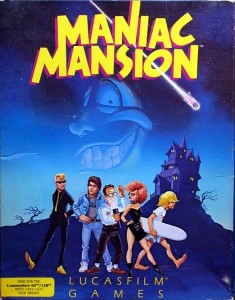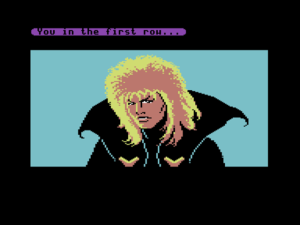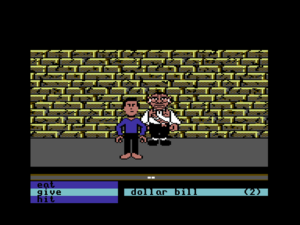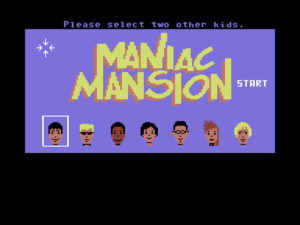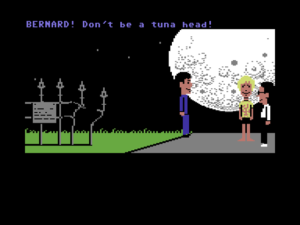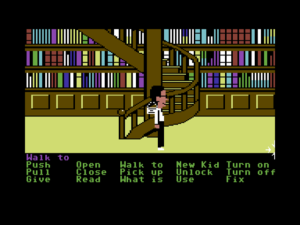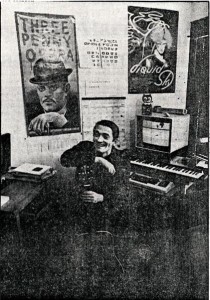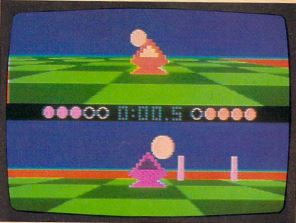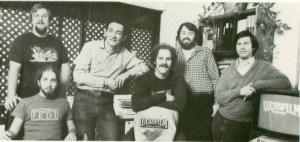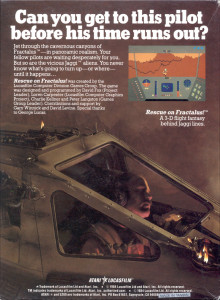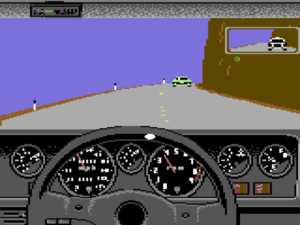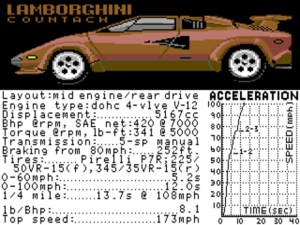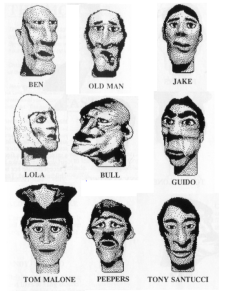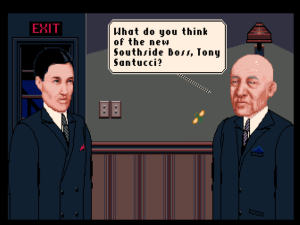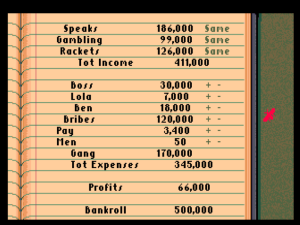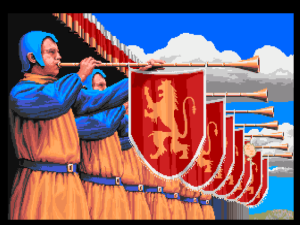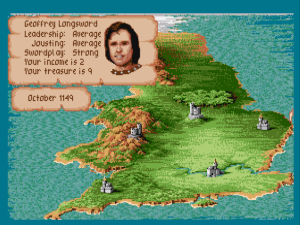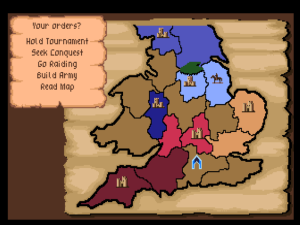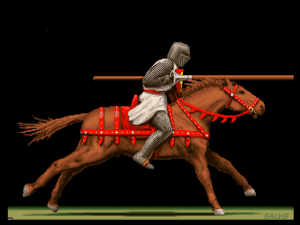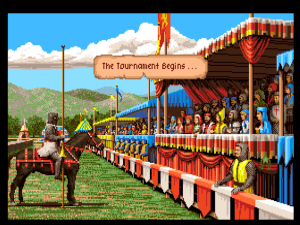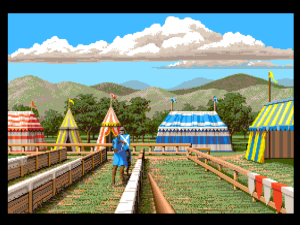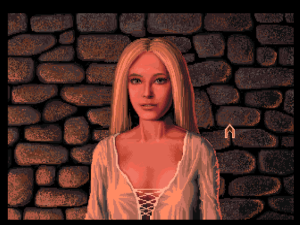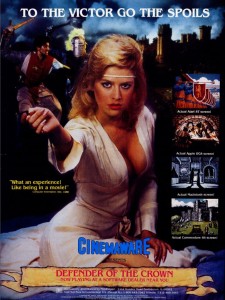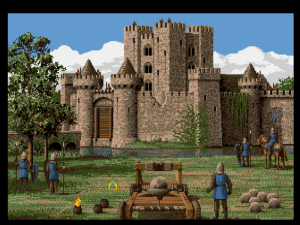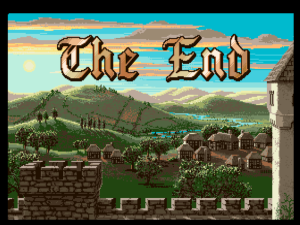As part of a general rearranging of the deck chairs at Lucasfilm in late 1985, the Games Group got moved from their nondescript offices in San Rafael to nearby Skywalker Ranch, the “filmmaker’s retreat” at the very heart of George Lucas’s empire. They were housed in an ornate structure of Victorian brick called the Stable House, with crackling fireplaces in almost every room. Later, old-timers would tell newcomers stories of the Games Group’s time at Skywalker Ranch, which would last for just a few years, like legends from before the Fall: catching a sneak preview of a new David Lynch film in the company of Lynch himself in the Ranch’s beautiful 300-seat art-deco theater; hanging out on a regular basis with Steven Spielberg, who wanted to play everything the Games Group had in development every time he stopped by, sometimes for hours at a stretch; playing softball on the Ranch’s gorgeously manicured field with rock star Huey Lewis; hiking up to the observatory after a long day at the office to do another sort of stargazing; eating gourmet lunches every day at the Ranch’s restaurant for $5 a pop. They might not have been able to make Star Wars games, but they could surround themselves with its trappings: when first moving in, they were given a chance to rummage through an enormous warehouse full of old props and concept art for office decorations. It’s questionable whether any other game studio, ever, has worked in quite such a nerd Elysium.
Continuing to blow through Skywalker Ranch as they had San Rafael, however, were winds of change that had been steadily altering Lucasfilm’s expectations of their little Games Group. As the middle years of the decade wore on, the company was becoming a very different place from what it had been during the free-and-easy early 1980s, when money seemed to flow like water. Lucasfilm’s financial outlook had changed almost overnight in 1983 when, even as Return of the Jedi was doing the expected huge numbers in theaters, George Lucas announced that he and his wife Marcia were getting a divorce. An accomplished film editor in her own right, Marcia had been a huge contributor to the Star Wars movies, especially the first, for which she’d won an Oscar — something her ex-husband has never managed — for her editing work. Now her divorce settlement would cost Lucasfilm big, to the tune of $50 to $100 million (precise estimates vary). Lucasfilm’s financial advisers were able to convince her to take her settlement as a series of payments spread over years rather than the lump sum the initial agreement demanded, but those payments nevertheless put a tremendous drain on the company’s finances.
And soon the other side of the ledger, that of incoming earnings, also began to diminish. George Lucas had long since declared that Star Wars was to be but a single trilogy of films, that there would be no more after Return of the Jedi. The lack of new films inevitably meant not just the loss of box-office receipts but also diminished sales of the toys and other merchandise that had always been the franchise’s biggest cash cow. Meanwhile the Indiana Jones series, which had turned into almost as successful a franchise as Star Wars, fell into a five-year hiatus after 1984’s Indiana Jones and the Temple of Doom. Filling that gap for Lucasfilm were a series of middling disappointments — Labyrinth, Tucker: The Man and His Dream, Willow, some almost perversely low-stakes Star Wars television programs featuring R2-D2 and C-3PO and, God help us, the Ewoks — and at least one outright bomb big enough to have become a punchline for the ages in Howard the Duck. It seemed that Lucas, who could do no wrong in the eleven years between American Graffiti and Indiana Jones and the Temple of Doom, had suddenly seen his Midas Touch desert him.
Never much of a manager and certainly not a numbers guy, Lucas hired a no-nonsense sort named Doug Norby to become Lucasfilm’s president in 1985. “Do what you have to do,” he told him, “and I’m just going to stay out of it.” Norby declared that there needed to be a culture change. Every division would now be expected to justify their existence by earning money for the company rather than costing it money. Those who couldn’t see a way to do so would get the axe. Ditto individual personnel within departments that had become too bloated; Norby orchestrated the first significant wave of layoffs ever to sweep over Lucasfilm. As the conflict-averse Lucas had likely intended, Norby was blamed for all of the pain and chaos, became for some time the most hated name at Lucasfilm, while Lucas himself was largely given a pass, as if he somehow didn’t know about the changes underway in his own namesake company.
As part of the restructuring, it was decided that Lucasfilm would now engage in only two specific lines of business: providing production services to the film industry (Industrial Light and Magic, Skywalker Sound) and making mass-market entertainments. The old Computer Graphics Group that had awkwardly spawned the Games Group still hadn’t really proved themselves to belong in the former category, while the Games Group, at least if you squinted just right, pretty much did belong in the latter. Thus, while the Games Group got to remain at Lucasfilm, the Graphics Group in February of 1986 was spun off to a collection of investors that included many of their own current personnel as well as, as ringmaster of the whole proceeding, Steve Jobs, recently exiled from Apple. The old Graphics Group was now known as Pixar, selling a $135,000 graphics workstation which they had developed during their years with Lucasfilm. Most of the rest of Lucasfilm’s computer-oriented research was either cancelled outright or similarly packaged up and sold off. (Most notably, Lucasfim’s EditDroid digital-editing project became an independent company called Droid Works.)
Soon the old Games Group represented the only significant hacker presence left at Lucasfilm. It was during this period of colossal change that George Lucas took rare personal notice of Games for long enough to deliver his most oft-quoted piece of advice to Steve Arnold: “Stay small, be the best, don’t lose any money.” This commandment has often been taken to represent a sort of creative carte blanche for Arnold and his charges. Taken in the context in which it was uttered, however, it’s probably better seen as a warning. The Games Group was free to continue to trade on the Lucasfilm name and enjoy their gourmet lunches at the company cafeteria, but they’d have to start paying their own way from here on. Should they fail at that, their rope would not be a long one, for Lucas had little personal investment in their work.
Given this situation, when Lucasfilm’s brass decided to throw the Games Group a bone in the form of an actual piece of intellectual property with which to work Arnold certainly didn’t turn up his nose at the prospect. It wasn’t Star Wars or even Indiana Jones, but it was a much-anticipated film called Labyrinth, a fantasy adventure directed by Jim Henson and starring David Bowie that was to be released in the summer of 1986. Beginning in November of 1985, Arnold poured most of his resources into the project, Lucasfilm Games’s first adventure game. The Henson connection secured the involvement of Christopher Cerf, a Sesame Street stalwart and all-around Renaissance man of the arts who seemed to know everyone and be involved with everything in the world of entertainment. Cerf was a good friend of Douglas Adams, a frequent guest at his legendary gala dinner parties; it had in fact been Cerf who had largely brokered the deal with Infocom that had led to the Hitchhiker’s Guide to the Galaxy computer game. In January much of the Games Group flew to London for an intense week of consultation with Henson, Cerf, and their buddy Adams.
Labyrinth had been conceived from the beginning as a graphic adventure, a genre that was just beginning to emerge from the primordial muck thanks largely to the work of Sierra and ICOM Simulations. It was Adams who suggested the game’s brilliant cold open: it begins as an ordinary text adventure, and not a very good one at that, until you arrive at a cinema and get sucked into the movie playing there by a pixelated David Bowie. It’s a ludic version of that iconic moment in The Wizard of Oz when the film suddenly shifts from black and white to color. Some of his other subversive touches, playing as he loved to do with the artificiality of the medium itself, weren’t so easily implemented. The team particularly lamented that they wouldn’t be able to use Adams’s idea for a film-editing room found in the game. He suggested that you should be able to view the scraps of film to see snippets of your own previous adventures, maybe even forgotten tributaries down which you’d wandered before restoring the game to its current state. Alas, something like that just wasn’t going to happen on the likes of a Commodore 64.
Not really a bad game but also not quite a fully baked one, Labyrinth would prove to be something of a steppingstone on the way to a grand tradition of Lucasfilm adventure games still to come. Your character can be moved about using the joystick, but other commands must be constructed rather awkwardly, by using the arrow keys to cycle through two separate lists, one of available verbs and one of nouns. Notably, when a verb is selected the list of nouns is limited to only those which logically apply, thus making it at least theoretically impossible to construct a completely nonsensical “sentence.” Driving much of the design was a philosophy that adventure games should be friendlier, less tedious, and much less deadly than was the norm from competitors like Sierra. It is, for instance, almost impossible to get yourself killed in Labyrinth, and David Fox noted in contemporaneous interviews how he had strained to “eliminate the dead-end or ‘insoluble’ situation.” In years to come Lucasfilm Games would virtually define themselves in opposition to what they saw as the Bad Old Way of doing adventure games, as particularly personified by the games of Sierra. It’s an idea that would take some experience and some technology upgrades to reach complete fruition, but it’s interesting to note that it was present right from the beginning.
Released in June of 1986, the movie version of Labyrinth thoroughly underwhelmed by the standards of an expensive would-be blockbuster, spending just one week inside the top ten in the United States and garnering mixed (at best) reviews. The odor of a flop inevitably clung to the game as well when it was released two months later. Despite lots of advertising and the usual free publicity garnered from journalists eager to come out to Skywalker Ranch and bask in the aura of Star Wars, it became on the whole a commercial disappointment. This was now becoming a depressingly common theme for the Games Group. They were perilously close to violating that last and most important of Lucas’s commandments.
Their savior would come from a much smaller, quieter project than the big Labyrinth tie-in — indeed, a project from which Steve Arnold seemed to have no real expectations at all. Its father had himself been heretofore one of the less noticeable employees of the Games Group, a friendly, unassuming fellow with a wry sense of humor and a great aptitude for programming. His name was Ron Gilbert, and he was motivated by that most compelling of all workplace impulses: he was just trying not to get fired.
Born in 1964 in the rural Oregon town of La Grande, Gilbert had been programming since 1977, when his father brought home the family’s first Texas Instruments programmable calculator. Soon after starting at his hometown Eastern Oregon State College in 1982, he bought his first Commodore 64, and immediately discovered one of that machine’s most conspicuous weaknesses: its BASIC interpreter had no support whatsoever for the very graphics and sound capabilities that made the 64 so special. Working with a buddy named Tom McFarlane, he developed a BASIC extension called Graphics BASIC to change all that, adding over a hundred new commands to the language. It was impressive enough that they were able to sell it to HESWare, one of the biggest publishers in software at the time. In fact, HESWare was so impressed with Gilbert personally that they offered him a full-time job as an in-house programmer. So, he dropped out of university to move to Brisbane, California.
It didn’t work out. HESWare turned out to be a flash in the pan that had made a ton of unwise financial decisions in their eagerness to rule the software roost. Within months of Gilbert’s arrival the company collapsed, well before releasing anything he had worked on. He was forced to return sheepishly to La Grande to contemplate re-enrolling at Eastern Oregon — luckily, his dad was the president there — and getting back to the real world of adult employment; maybe he could get a job as a programmer at a bank or something. Then, one day in October of 1984, the telephone rang just as he was leaving the house. Prompted by he wasn’t quite sure what, he decided to rush back inside and answer it. It was Steve Arnold from Lucasfilm Games. He and his colleagues had seen Graphics BASIC and heard about Gilbert’s talents through the grapevine, Arnold explained. They needed someone to help port their games, which had been originally developed for Atari 8-bit machines, to the Commodore 64. Would he be willing to come down to San Rafael to talk about a possible contract? Like most prospective employees Arnold spoke to, Gilbert didn’t have to think twice when the company behind Star Wars came calling. It was just an interview, and for a contract position at that, but he nevertheless packed all of his possessions into his 280Z and took off for California. He had no intention of coming back.
He didn’t need to; he got the job. Still, as a contractor rather than a regular employee he was left perpetually uncertain about how long he’d get to live the dream. His anxiety only increased after the Commodore 64 versions of the Games Group’s modest early catalog of four action games were all pretty much complete and nobody seemed to be giving him any clear information about what he was expected to do next. Working with a couple of the other guys, he came up with a fanciful game proposal for Arnold’s bulging ideas file: I Was a Teenage Lobot, a “science-fiction role-playing strategy adventure game.” (Better check again, guys; I think you may have missed a genre or two.) But then the big Labyrinth project came along, depriving him of his would-be partners. Ominously, Gilbert was one of the few people in the Games Group not earmarked to that game.
Whether Steve Arnold was really snubbing him or whether he saw something special in him and wanted to give him his own space to figure out for himself what that was is still an open question. What is clear is that Gilbert started toying with another idea to justify his existence there at Skywalker Ranch, involving a group of kids sent, Scooby-Doo-style, to explore a creepy old mansion.
Gilbert claims that he didn’t originally conceive of Maniac Mansion as an adventure game at all, perhaps because one of its central conceits had rarely been done in an adventure game before. From the beginning, he was determined that you should be able to control several kids rather than just one, each of whom would have her own personality and abilities. Much of the gameplay would hinge on coordinating the kids’ actions to achieve things none of them could manage on her own. And that was pretty much the whole idea; just about everything else about the design seemed to be up in the air. But then, visiting home for the Christmas of 1985, he saw his eight-year-old cousin obsessively playing Sierra’s King’s Quest. Gilbert loved the graphics, but didn’t care for Roberta Williams’s death-heavy philosophy of game design any more than he did for Sierra’s primitive parser, which made a particularly poor fit with a game that was otherwise so graphics-oriented. He decided that he wanted to do an adventure game “because I hate adventure games,” because he wanted to show the world how they could be so much better.
I hated that you died all the time. You’d be walking along and you would step somewhere and out of the blue you would die. That just seemed frustrating to me. I think a lot of designers must think that’s fun. But it’s not. It’s horrible.
And too often the game devolved into what Gilbert calls “second-guess the parser”:
You would see a bush on the screen, and you’d type, “Pick up bush,” and it would say, “I don’t know what a ‘bush’ is.” Then you’d type, “Pick up plant,” and it would say, “I don’t know what a ‘plant’ is.” Then you’d type, “Pick up shrubbery,” and it would say, “I don’t know what a ‘shrubbery’ is.” Pretty soon you’d type, “Fuck you,” and it would say, “I don’t understand what ‘fuck’ is.”
So, I’m looking at this bush or plant or shrub and I cannot figure out the word that the game designer is using for it. That’s very frustrating because I can see it right on the screen. Why can’t I just click on it?
And the next logical step is: if I can just click on objects on the screen, why can’t I just click on verbs as well? Really, despite what the marketing departments and the backs of the boxes were telling us, these games only understood a very small number of verbs.
Beginning from textual lists of verbs and nouns much like the interface of Labyrinth, Maniac Mansion evolved into a much more intuitive experience: a clickable list of verbs at the bottom of the screen, which can be combined with hotspots in the pictures proper to build commands. In its day it was simply the best, most elegant interface for graphical adventuring yet devised. One might call it a combination of the best traits of the two most prominent systems for graphic adventuring already extant at the time: Sierra’s AGI games that debuted with King’s Quest and the ICOM Simulations line of adventures that began with Déjà Vu. Like the former, you can see your avatar (or avatars in this case) and move them about onscreen, but like the latter you don’t have to wrestle with a parser, being able instead to simply click on verbs and objects in your inventory or in the environment proper to construct commands. It’s afflicted with neither the perpetual disconnect between textual parser and graphical worldview that can make the AGI games so frustrating nor the cluttered, cramped feel of ICOM’s overly baroque interface. Maniac Mansion would prove to be by far the most graphical graphical adventure of its time, willing to do most of its storytelling through visuals and the occasional well-chosen sound effect rather than the big text dumps that mark the Sierra and ICOM games. Tellingly, it devotes exactly one line of the screen to text messages.
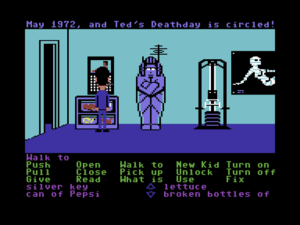
On the job in Maniac Mansion. Note the selectable list of verbs (including the immortal “New Kid”) and the character’s inventory below.
Gilbert found a great supporter of his budding adventure game in Gary Winnick, the Games Group’s indefatigable visual artist. In between contributing much of the art found in both Labyrinth and Habitat, Winnick found time to brainstorm Maniac Mansion and to create heaps of sample art. Yet progress was painfully slow. Gilbert was trying to build Maniac Mansion in the same way that Labyrinth was being built, by coding it from scratch in pure assembly language. Problem was, he was trying to do it alone. As 1986’s midpoint approached, Steve Arnold was getting noticeably annoyed at his apparent lack of productivity and Gilbert was surer than ever that he would be sent back to La Grande any day now.
It was at this juncture that Chip Morningstar made the suggestion that would change the direction of Lucasfilm Games forever. Why didn’t he devise a high-level scripting language that could be compiled on the Games Group’s big Unix workstations, then run on the Commodore 64 itself via an interpreter? Morningstar even took the time to help him design the language, a sort of cut-down version of some of the tools he and Randall Farmer were using to build the virtual world of Habitat, and to write the first compiler. SCUMM — the Script Creation Utility for Maniac Mansion — was born.
It wasn’t precisely a new idea, but it was vastly complicated by the need a graphic adventure like Maniac Mansion had to do many things concurrently, in real time. Many different “scripts” would need to run at the same time, forcing Gilbert to code what amounted to a multitasking kernel for the whole system on the little Commodore 64. Even with Morningstar’s help, it took Gilbert a full six months to get the SCUMM system up and running. Meanwhile Gary Winnick’s art continued to pile up, looking for a home, and Gilbert continued to tremble every time Steve Arnold looked his way. At last at the end of 1986 SCUMM was complete enough that he could return to the game proper. Arnold, evidently beginning to feel that his work had real potential, allowed David Fox to join him as a SCUMM scripter. Winnick as well was now working virtually full-time on the project, contributing not only all of the art but also major swathes of design and story.
Gilbert credits SCUMM and the relative ease with which it let the programmer script interactions for making the world of the finished Maniac Mansion much more interactive and alive than it could otherwise have been. Not least amongst the little gags and Easter eggs SCUMM facilitated was a certain soon-to-be-infamous hamster-in-a-microwave bit. Gilbert insists that it was actually Fox and Winnick who came up with and implemented this particular piece of tasteless humor, so angry missives should be directed their way rather than to him.
Winnick drew the kids you control and the other characters that inhabit the mansion like bobblehead dolls, heads out of all proportion to their bodies, to make sure their personalities came across despite the low screen resolution of the Commodore 64. He had already used the same technique in both Labyrinth and Habitat and would continue to do so for some time to come; it would become the most instantly recognizable graphical trait of early Lucasfilm adventure games. Gilbert’s original plan had called for the kids to literally be kids — children. Realizing, however, that no one wanted to see children endangered and potentially dispatched in gruesome ways, Gilbert and Winnick decided to make the kids teenagers, which made a better demographic fit anyway with the teenage players who were the biggest audience for computer games. They form a group of seven broad high-school archetypes, sketched with just a hint of a satirical edge, from amongst which you choose three to see you through the game. Bernard is an electronics buff, physics champion, and all-around nerd; Wendy is a prim and proper “aspiring novelist” who seems to have been born at age 40; Michael is Yearbook Guy at the school, an ace photographer; Jeff is a surfer dude who seems to have wandered into Maniac Mansion whilst looking for California Games; and, betraying perhaps a slight flagging of the creative muscles, both Sid and Razor are would-be rock stars (Sid’s a new waver, Razor a punk, for whatever that’s worth). And finally there’s Dave, a Good Kid of the sort who runs for Class President. He’s the leader of the group and the one kid you have to play with. It’s his girlfriend Sandy — a cheerleader, naturally — who’s been kidnapped by Dr. Fred, the creepy owner of the mansion, to feed to aliens. Some real people found themselves immortalized inside these archetypical shells: Razor’s look was based on Winnick’s girlfriend, Wendy on an accountant (what else?) at the office, Dave on Ron Gilbert himself. All of the kids have unique talents, some expected, some less so; clueless Jeff’s inexplicable hidden talent for fixing telephones is actually one of the funniest gags in the game. The idea was that any combination of kids should be capable of solving the game.
It was an idea that would cause Gilbert and Winnick no small amount of angst. Neither had ever designed an adventure game before, much less a knotty tapestry like this with its combinatorial explosion of protagonists, and their design document consisted of little more than a map of the mansion and a list of objects and the puzzles to which they applied. They desperately wanted to create an adventure game that would be more friendly and forgiving than the typical Sierra effort, but, inevitably, their lack of experience and planning and time, not to mention play-testing — the Games Group’s testing department consisted of exactly one guy sitting in front of a Commodore 64 with a pad of paper — led to a game fairly riddled with potential dead ends and unwinnable situations despite its designers’ best intentions. Gilbert, a great and much-needed advocate for fairness in adventure design, still castigates himself for that to this day.
Both Gilbert and Winnick were fans of knowingly schlocky B-grade horror movies like the then-recent Re-Animator. Maniac Mansion was conceived very much as an homage to the genre. The actual plot, of the mad scientist who owns the mansion attempting to tap the power of a mysterious meteorite that fell on his property, was inspired by one of the vignettes in Creepshow, an anthology of short horror films. Other references, like the man-eating plant lifted whole cloth from Little Shop of Horrors, are even more obvious. Still, it was going to have to be a much more family-friendly affair if it was to bear the Lucasfilm name. When Arnold demanded that all traces of swearing be removed from the game, Gilbert and Winnick did so only under duress, and to the tune of plenty of grumbling about “artistic vision” and the like. If you can tell me exactly why Dave has to call Bernard a “shithead” at the outset of the night, said Arnold, you can keep it. No one could. Gilbert says that the lesson thus imparted about the pointlessness of gratuitous profanity has stuck with him to this day.
For the mansion itself, they found a fecund source of inspiration very close to home indeed: the big neo-Victorian “Main House” at Skywalker Ranch. The spiral staircase inside the library in Maniac Mansion is lifted straight from the “filmmaker’s research library” in the Main House. In the game, the staircase has an “out of order” sign on it and cannot be climbed under any circumstances. This was a subtle inside joke: George Lucas’s personal office was on the balcony at the top of those stairs in the real house, and nobody was allowed to go up there without an invitation.
Given that it was a game inspired largely by movies that was being developed at a movie studio, Gilbert wanted to give Maniac Mansion a cinematic flavor. He imagined little episodes that would “cut away” from the player’s current actions to advance the plot and show what the captive Sally, her captor Dr. Fred, and the other creepy inhabitants of the mansion were up to. He asked Arnold if there was a filmmaking term for this technique that he could employ. Arnold said that “cut scene” sounded more than good enough to him. Thus did a new term enter the gaming lexicon. Maniac Mansion was hardly the first game to employ them — there was Jordan Mechner’s 1984 classic Karateka and Sierra adventure games like Space Quest and even the old Ms. Pac-Man game in the arcades — but it had been left to Lucasfilm to finally give them a name. The concept was baked right into the SCUMM language, with a special kind of script called simply “cut-scene” that when triggered would automatically save the player’s state, play the cut scene as a little animated movie all its own, and then restore the player to control.
One ironic consequence of the cut scenes is to make the game harder in just the ways that Gilbert would have preferred to avoid. Most of them are triggered by simple timers. While some are just there for atmosphere or to convey information, others directly affect the state of the world, such as when a postman arrives with a package. There are often things you must do to react or to prepare for these dynamic events; failing to do so can lock you out of victory. Had anyone been paying attention, Infocom’s Ballyhoo had already pioneered a better way to advance the plot inside an adventure game, by tying events to the player’s progress rather than hard-coded timers. Like many such lessons, it would be learned only slowly by game designers, and largely by a process of reinventing the wheel at that. As it is, Maniac Mansion has some of the feel of the earlier Infocom mysteries, of needing to learn how to steer events just right over the course of multiple restores.
Shortly before the release of Labyrinth, Lucasfilm Games had severed their relationship with Epyx and moved on to Activision. It was thus under that company’s banner that Maniac Mansion made its public debut at the June 1987 Summer Consumer Electronics Show, host to so much of the last great wave of Commodore 64 software. Before Maniac Mansion could actually be released, however, Arnold made the huge decision to self-publish it under Lucasfilm’s own banner. Lucasfilm Games changed from being a mere developer to being an “affiliated publisher” of Activision, a status that gave them more independence and put their own name alone on their boxes but still gave them access to the larger company’s distribution network and other logistical support. Even with Activision’s support, publishing entailed engaging with entire facets of the software industry from which they’d always been happily insulated before. They learned a harsh lesson about the sensitivities of some Americans when Toys ‘R’ Us, one of the biggest Commodore 64 game retailers in the country, abruptly pulled the game off their shelves in response to a customer complaint. It seemed some old biddy had seen the tongue-in-cheek copy on the back of the box, which declared Maniac Mansion to be (amongst other things) a story of “love, lust, and power,” and had objected in no uncertain terms. Lucasfilm was forced to hurriedly redesign the box in order not to lose Toy ‘R’ Us forever.
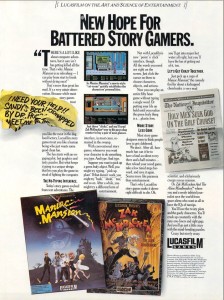
Lucasfilm Games’s advertisements took aim at “most story game designers” who “seem to think people love to get clobbered.” I wonder which designers they’re talking about…
But it all worked out in the end. Coming out as it did with the Lucasfilm Games logo — and only the Lucasfilm Games logo — all over its box, Maniac Mansion proved a pivotal release for this little concern that, despite brilliant personnel and a name to die for, had struggled for years now to come up with a definitive commercial identity. One of the huge advantages of the SCUMM system was that it made porting games to new platforms relatively easy, just a matter of writing a new interpreter. Thus by 1988 Maniac Mansion could be bought in versions for the Amiga, Atari ST, Apple II, and MS-DOS in addition to the Commodore 64 original. In time it would even make its way to the Nintendo Entertainment System. (See Doug Crockford’s “The Expurgation of Maniac Mansion“ to learn of the hilarious lengths the Games Group had to go through to get it accepted by Nintendo’s censorious management regime, who made the Toys “R” Us lady look like a libertine.) While it never topped many sales charts, Maniac Mansion turned into a perennial back-catalog star, selling far more units when all was said and done than any game the Games Group had released before. Its continuing popularity was such that in 1990 it spawned a successful children’s television series, a claim to fame that very few games can boast. Such success enabled Lucasfilm Games at last to firmly plant their feet and adhere to Lucas’s dictum to “not lose any money” while they built upon the reputation it engendered for them. They were now known first and foremost as a maker of graphic adventure games, the yin to Sierra’s yang. They had traveled a long and winding road to get here, but it seemed they had finally found a calling.
Maniac Mansion’s intrinsic value as a game is often dismissed today in favor of its historical role as the urtext for the many much-loved SCUMM games that followed it. That, however, is a shame, for its charms as the best graphic adventure ever made for the Commodore 64 are real, varied, and considerable. Yes, it’s a bit of shaggy beast in contrast to those later Lucasfilm classics, but it’s also in many ways the most complex and interesting of any of them; no other SCUMM game boasts anything like its seven different playable characters, with all of the alternate storylines and solutions they bring with them.
Yet the most winning thing about Maniac Mansion is its personality, which is in turn a tribute to the personalities who created it. Gilbert and Winnick, one senses, want you to have a good time, want you to solve the game and then come back for more, trying on new combinations of characters for size. Thanks largely to the essential good faith and sense of fair play with which its authors approached it, Maniac Mansion is a game that’s hard to dislike, despite its occasional sins in the form of a puzzle or two that could have been clued slightly better and one really egregious example of hunt-the-hotspot (hint: check the library very carefully). Its puzzles are varied, usually logical in their wacky way, and always entertaining, and are given a wonderful added dimension by the need to coordinate two or sometimes even all three kids in far-flung corners of the mansion to solve some of the more intricate problems. (Interestingly, Level 9 in Britain was doing much the same thing during the same time period in the realm of text adventures.) One other thing that helps immeasurably is that the mansion is a relatively constrained environment, limiting the scope of possibility enough to keep things manageable. And of course it also helps that the game manages to evoke the sylvan atmosphere of a long teenage summer night so beautifully using the blunt instrument of 8-bit graphics and sound. Likeability, good faith, and good intentions will get you a long way, in games as in life, and talent doesn’t hurt one bit either. Thankfully, Ron Gilbert, Gary Winnick, and their colleagues were possessed of all of the above in spades.
(Sources: the book Droidmaker by Michael Rubin; The Transactor of July 1986; The LucasArts Adventurer of Spring 1991; Commodore Magazine of June 1987 and November 1988; Computer and Video Games of December 1986; Retro Gamer 94 and 116. Ron Gilbert has a wealth of material on his own history on his website and his “Making of Maniac Mansion” presentation was also invaluable.
Feel free to download the Commodore 64 version of Maniac Mansion from here.)
